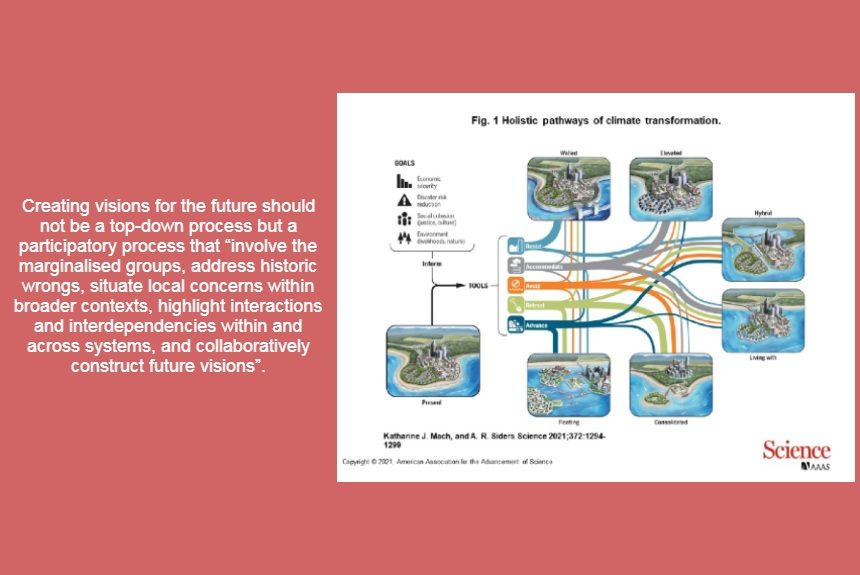Societies must transform to adapt to climate change and manage the risks it brings, such as extreme heat, wildfires, sea-level rise, and flooding. However, the scope or extent of these societal changes will depend on what societies prioritise and value.
A study by Mach and Siders, published in Science Magazine, reconceptualises strategic management retreat by contrasting it with past practice. The researchers posit that when implemented, strategic management retreats can help societies effectively adapt to climate change because it is equitable and considers the values and cultures of affected communities.
Reframing a managed retreat involves reframing questions that are often asked about it. This uncovers the many concerns that have not been fully addressed.
Instead of asking where climate retreat will occur, policymakers should ask where resources will be allocated to prevent unmanaged retreat and where the strategic, managed retreat will occur.
Unmanaged retreat occurs when there are no options left but to leave the place.
In contrast, managed retreat involves deploying available resources and support for communities to achieve a desirable future.
Adaptation resources are limited, affecting decisions about prioritising climate adaptation actions. The study categorised climate adaptation actions as resistance, accommodation, avoidance, retreat, and advance to address risks.
According to the study, “resistance reduces exposure by armouring or keeping hazards at bay, whereas advance builds into hazardous areas (e.g., through land reclamation). Accommodation measures such as infrastructure elevation or warning systems reduce sensitivity to hazards. Avoidance limits new development in hazardous locations, and retreat removes people and assets from hazardous places after development. Each adaptation action represents a distinct value-laden decision about what to preserve, purposefully change, or allow to change unguided. Retreat has often been viewed as a failure to adapt or considered only when all other options are exhausted. But this conceptualisation ignores lessons from numerous disciplines drawing on a long history of human movement and limits adaptation researchers and decision-makers in preparing for a broad range of futures.”
Disparities in climate adaption
By 2100, displacement from sea-level rise will range from 88 million to 1.4 billion; this depends on whether the estimate includes people living in low-lying coastal areas, areas that will be permanently flooded, or areas that have historically flooded.
Climate adaptation spending highlights income disparities. According to one analysis, only high-income countries can afford climate adaptation through resistance or armouring.
Armouring will be an economically sound adaptation solution for 13% of the global coastlines, mainly in high-income countries. For 65% of the world’s coastlines, which are composed of small islands and rural coastlines, allowing unmanaged retreat will minimise total costs, assuming that little or no public funds and no external support are available.
Gains and losses from managed retreat
The study also discusses the benefits and harm of retreat. Climate adaptation and transformation are all about change that will involve losses and gains for people. To determine whether retreat will benefit or harm people, reframing the question as such: Does managing retreat produce greater or lesser gain or loss compared to other actions? Secondly, how can a retreat be implemented to maximise its benefits and minimise losses?
Adaptations for the future
Future visions of adaptation can sometimes involve bold visions and pathways. However, decision-making in climate adaptation is sometimes based on deep uncertainty and not on acknowledged best practices, which may not represent the participants’ values and culture.
Creating visions for the future should not be a top-down process. Still, it should be a participatory process that “involves the marginalised groups, addresses historic wrongs, situates local concerns within broader contexts, highlights interactions and interdependencies within and across systems, and collaboratively constructs future visions.”
To read the entire study, click the link below:
Source Citation:
Mach, K. & Siders, A. (2021, June 18). Reframing strategic, managed retreat for transformative climate adaptation. Science. Vol. 372, Issue 6548, pp. 1294-1299. DOI: 10.1126/science.abh1894
BACKGROUND IMAGE CREDIT: Fig. 1 Holistic pathways of climate transformation by E. Hartley. Source: https://science.sciencemag.org/content/sci/372/6548/1294/F1.large.jpg



Leave a Reply